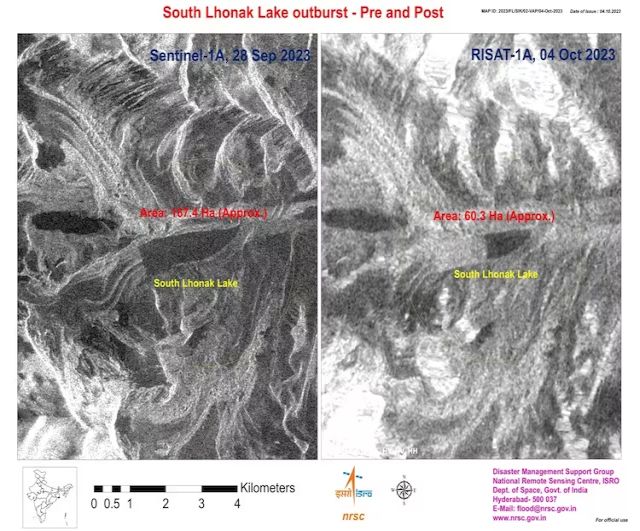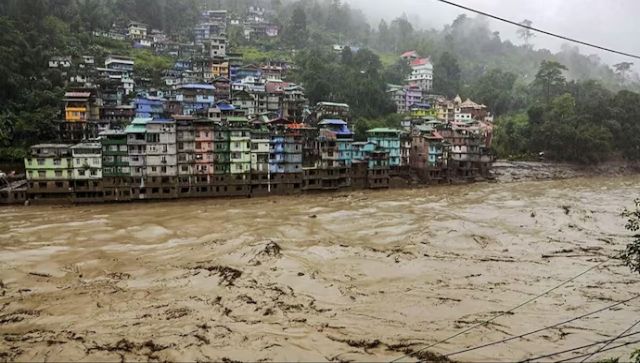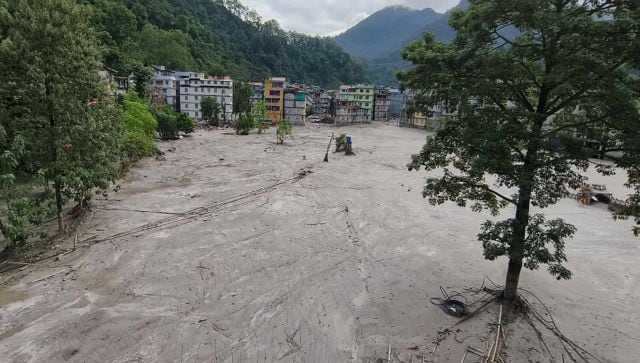The tragedy in Sikkim continues to unfold. Two days after flash floods hit the northeastern state the death toll has mounted to 22 with 103 people, including 22 army personnel, still missing. It all started after incessant rains and a possible cloudburst over the South Lhonak glacial lake situated at 17,000 feet in the state’s northwest. The lake burst, leading to the release of water downstream. This resulted in water levels of the Teesta River rising rapidly and flooding at least four districts. Now studies say that the South Lhonak Lake grew in size rapidly because of melting glaciers, making it susceptible to glacial lake outburst flood (GLOF) . If there were warnings, why were they ignored? Could the Sikkim floods be averted? We take a look.
What studies have warned about GLOF There have not been one but several warnings, which point that the Sikkim disaster was in the making for years. One of the first alerts was raised back in 2001. The Sikkim Human Development Report spoke of the “catastrophic” impact of GLOF and highlighted the state’s Onglokthang, Rathong Chu and Zemu glaciers, which had even then retreated by several kilometres, according to NDTV. “Disturbances in mountain ecology have started attracting considerable attention. The phenomenon of jokulhlaup (glacier leap), also known as glacial lake outburst floods (GLOF), is a frequent and alarming occurrence in Sikkim. As the state is dotted with many glaciers, this is a serious potential hazard,” according to the 2001 report. How the South Lhonak Lake retreated Yet another study from 2013 specifically mentions South Lhonak Lake. A study conducted by the National Remote Sensing Centre and the Indian Space Research Organisation in 2012-2013 discussed the formation of a moraine-dammed glacial lake at the snout of the South Lhonak glacier and the associated risks. “The (South Lhonak) lake outburst probability shows a very high value of 42 per cent for the lake, and the peak discharge estimated using the empirical formula shows a discharge of 586 m3/s,” the study said. In 2016, the Sikkim government’s Department of Science and Technology conducted an expedition to estimate the lake’s volume, led by Sonam Wangchuk of the Ladakh-based NGO Students’ Educational and Cultural Movement of Ladakh. The expedition warned about the potential of a GLOF event, reports news agency Press Trust of India (PTI). [caption id=“attachment_13211382” align=“alignnone” width=“640”] The area of the South Lhonak Lake before and after the tragedy. Image courtesy: ISRO[/caption] As recently as September 2021, a study published in the journal Geomorphology cautioned against the “accelerated growth” of glacial lakes in Sikkim, particularly the South Lhonak glacier. “In Sikkim, the lake-terminating glaciers have shown accelerated growth compared to the glaciers with no lakes (Aggarwal et al., 2017). South Lhonak glacier is no different; it is one of the fastest retreating glaciers and the associated proglacial lake has become the largest and fastest-growing in the state,” it said. The glacier, it pointed out, receded about 2 km in 46 years from 1962 to 2008. It further retreated by about 400 metres from 2008 to 2019. “It has been a growing concern now about the hazard potential of this lake, as the downstream valley is heavily populated with numerous settlements and infrastructure,” the paper cautioned. Another study projected a three-fold increase in the risk of GLOF hazards across high-mountain regions in Asia with the eastern Himalayas being a hotspot, according to a report in The Times of India (ToI). What have experts said While talking about the risk of GLOF at South Lhonak, Ashim Sattar, the lead author of the 2021 research told ToI, “This was a known vulnerability.” He said that all of the lake water did not drain out after the dam burst. “It could have been worst.” Dr SN Remya, the lead scientist of the 2013 paper was quoted by NDTV as saying, “We predicted (in 2013) the probability of the South Lhonak glacier breaking is 42 per cent. Regarding the lake burst in Sikkim, we predicted it would result in the release of up to 19 million cubic meters of water. We had said this lake is in danger… recommended early warning systems.” What have authorities done so far The Central Water Commission, Government of India, initiated an advisory to evaluate the South Lhonak glacier and its lake system. The initial hazard assessment of the South Lhonak Lake based on the current condition suggests that the lake has great potential to significantly impact the downstream region, according to the 2021 paper. One of the field expeditions in August 2014 by a team from the Snow and Avalanche Study Establishment (SASE) and Sikkim Department of Science and Technology and Climate Change and other stakeholders reiterated the threat of “devastation” and asked for a mitigation management plan, and suggested “siphoning” as a short term measure, reports Hindustan Times. Siphons are inverted pipes that are used to allow atmospheric pressure to force water from a reservoir over an embankment dam, then released from the other end of the pipe, the report says. [caption id=“attachment_13211472” align=“alignnone” width=“640”]
The area of the South Lhonak Lake before and after the tragedy. Image courtesy: ISRO[/caption] As recently as September 2021, a study published in the journal Geomorphology cautioned against the “accelerated growth” of glacial lakes in Sikkim, particularly the South Lhonak glacier. “In Sikkim, the lake-terminating glaciers have shown accelerated growth compared to the glaciers with no lakes (Aggarwal et al., 2017). South Lhonak glacier is no different; it is one of the fastest retreating glaciers and the associated proglacial lake has become the largest and fastest-growing in the state,” it said. The glacier, it pointed out, receded about 2 km in 46 years from 1962 to 2008. It further retreated by about 400 metres from 2008 to 2019. “It has been a growing concern now about the hazard potential of this lake, as the downstream valley is heavily populated with numerous settlements and infrastructure,” the paper cautioned. Another study projected a three-fold increase in the risk of GLOF hazards across high-mountain regions in Asia with the eastern Himalayas being a hotspot, according to a report in The Times of India (ToI). What have experts said While talking about the risk of GLOF at South Lhonak, Ashim Sattar, the lead author of the 2021 research told ToI, “This was a known vulnerability.” He said that all of the lake water did not drain out after the dam burst. “It could have been worst.” Dr SN Remya, the lead scientist of the 2013 paper was quoted by NDTV as saying, “We predicted (in 2013) the probability of the South Lhonak glacier breaking is 42 per cent. Regarding the lake burst in Sikkim, we predicted it would result in the release of up to 19 million cubic meters of water. We had said this lake is in danger… recommended early warning systems.” What have authorities done so far The Central Water Commission, Government of India, initiated an advisory to evaluate the South Lhonak glacier and its lake system. The initial hazard assessment of the South Lhonak Lake based on the current condition suggests that the lake has great potential to significantly impact the downstream region, according to the 2021 paper. One of the field expeditions in August 2014 by a team from the Snow and Avalanche Study Establishment (SASE) and Sikkim Department of Science and Technology and Climate Change and other stakeholders reiterated the threat of “devastation” and asked for a mitigation management plan, and suggested “siphoning” as a short term measure, reports Hindustan Times. Siphons are inverted pipes that are used to allow atmospheric pressure to force water from a reservoir over an embankment dam, then released from the other end of the pipe, the report says. [caption id=“attachment_13211472” align=“alignnone” width=“640”] The death toll in the flash flood in Sikkim has mounted to 22. There has been large-scale devastation in at least four districts in the state. PTI[/caption] Dilliram Dahal, assistant professor at Namchi Government College, Sikkim, revealed that high-density polyethylene pipes were installed to siphon off water from the glacial lake following the expedition to prevent a GLOF event. A monitor for water levels was also installed. In September this year, officials from the Science and Technology Department, the Sikkim State Disaster Management Authority, and the Land and Revenue Department conducted another inspection at the lake to install an early warning system and automatic weather station, reports PTI. The first part of the system, a camera to monitor Lhonak Lake’s level and weather instruments, was installed last month, officials involved in the project told Reuters. If fully operational, the
warning system
could have given people more time to evacuate, scientists said. One scientist said glacial early warning systems can typically give residents a few minutes to an hour of notice. “It’s quite absurd, really,” said geoscientist Simon Allen of the University of Zurich who is involved with the project. “The fact it happened just two weeks after our team was there was completely bad luck”. He said they planned to add a tripwire sensor that would trigger if the lake was about to burst. That would typically be connected to an alert system or siren that would warn residents to immediately evacuate to higher ground, reports Reuters. “The Indian government was not prepared to do that this year, so it was being done as a two-step process,” he said. The monitoring devices were supposed to send data to authorities, but the camera lost power for an unknown reason in late September, according to a source at the Swiss embassy, which supported the project. [caption id=“attachment_13211502” align=“alignnone” width=“640”]
The death toll in the flash flood in Sikkim has mounted to 22. There has been large-scale devastation in at least four districts in the state. PTI[/caption] Dilliram Dahal, assistant professor at Namchi Government College, Sikkim, revealed that high-density polyethylene pipes were installed to siphon off water from the glacial lake following the expedition to prevent a GLOF event. A monitor for water levels was also installed. In September this year, officials from the Science and Technology Department, the Sikkim State Disaster Management Authority, and the Land and Revenue Department conducted another inspection at the lake to install an early warning system and automatic weather station, reports PTI. The first part of the system, a camera to monitor Lhonak Lake’s level and weather instruments, was installed last month, officials involved in the project told Reuters. If fully operational, the
warning system
could have given people more time to evacuate, scientists said. One scientist said glacial early warning systems can typically give residents a few minutes to an hour of notice. “It’s quite absurd, really,” said geoscientist Simon Allen of the University of Zurich who is involved with the project. “The fact it happened just two weeks after our team was there was completely bad luck”. He said they planned to add a tripwire sensor that would trigger if the lake was about to burst. That would typically be connected to an alert system or siren that would warn residents to immediately evacuate to higher ground, reports Reuters. “The Indian government was not prepared to do that this year, so it was being done as a two-step process,” he said. The monitoring devices were supposed to send data to authorities, but the camera lost power for an unknown reason in late September, according to a source at the Swiss embassy, which supported the project. [caption id=“attachment_13211502” align=“alignnone” width=“640”] Buildings are inundated after flash floods swamped Rangpo town in Sikkim. AP[/caption] How bad is the situation in Sikkim now? As the death toll continues to rise, authorities are on alert. The Shako Cho glacial lake near Lachen in Mangan district, which is hit by the floods, is showing signs of bursting. This could only aggravate the tragedy. As per authorities, a breach warning is in place as an abnormal increase in glacial temperature has been recorded above Shako Cho, which could prompt a sudden discharge of water into the lake, reports News18. Authorities are evacuating those residing on the banks of Shako Cho as a precautionary measure. According to Sattar, Sikkim has 14 lakes which are as large as South Lhonak Lake. A recent study by him pointed out that 70 per cent of glacial lakes in the Hindu Kush Himalayas were vulnerable to landslide and avalanche-type events. With inputs from agencies
Buildings are inundated after flash floods swamped Rangpo town in Sikkim. AP[/caption] How bad is the situation in Sikkim now? As the death toll continues to rise, authorities are on alert. The Shako Cho glacial lake near Lachen in Mangan district, which is hit by the floods, is showing signs of bursting. This could only aggravate the tragedy. As per authorities, a breach warning is in place as an abnormal increase in glacial temperature has been recorded above Shako Cho, which could prompt a sudden discharge of water into the lake, reports News18. Authorities are evacuating those residing on the banks of Shako Cho as a precautionary measure. According to Sattar, Sikkim has 14 lakes which are as large as South Lhonak Lake. A recent study by him pointed out that 70 per cent of glacial lakes in the Hindu Kush Himalayas were vulnerable to landslide and avalanche-type events. With inputs from agencies
)